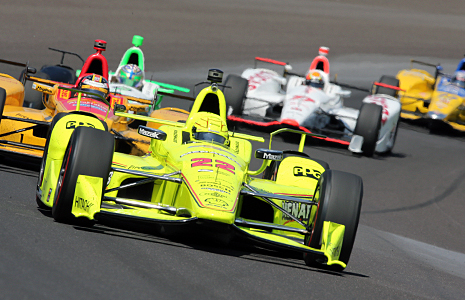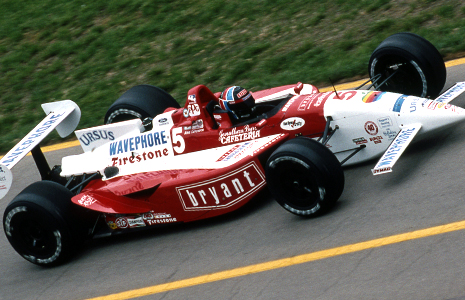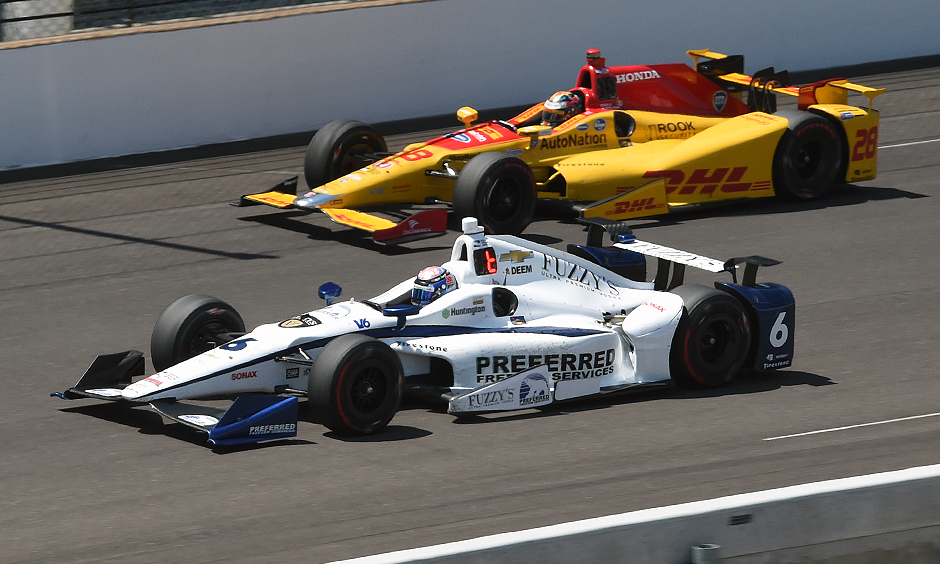INDYCAR Voices: Superspeedway downforce and its effects
AUG 16, 2016
(This is the last of a three-part series from Verizon IndyCar Series driver JR Hildebrand discussing the effects of Indy car downforce at different types of tracks. This installment looks at superspeedways, including the Indianapolis Motor Speedway.)
We’ve talked about road and street circuits; we’ve talked about short ovals. We’ve talked about downforce, drag, power and tires (mechanical grip), and the relationship that each of those things has together. Now let’s talk about what impact they have on INDYCAR’s superspeedway formula.
I’ve been on brief hiatus from writing these columns while working with Ed Carpenter Racing, filling in and standing by for my dude Josef Newgarden, as you guys know. Some of that filling in actually included doing aero configuration testing for INDYCAR along with Tony Kanaan, somewhat fortuitous given that I’ve been writing these articles.
Having done so, it’s worth noting that the Verizon IndyCar Series is actively testing some of the very things that we’ve been talking about, and with some real purpose to continually improve the on-track product that is on display. If you have an opinion, voice it! They’re collecting a lot of data and looking at a variety of scenarios.
But now, as the third superspeedway on the schedule approaches this week at Pocono Raceway, it’s time to dig in to what you see on track at places like this and, of course, the Indianapolis Motor Speedway. We’ve established in previous columns that the current Indy car is capable of making a ton of downforce, put to use with great effect in terms of total performance over a lap everywhere we’ve looked. But what about at a place like Indy where the configuration is totally different?
Just as in the other situations, how the cars drive, how they race and what you observe as fans comes down to the relative weight that downforce, drag, power and mechanical grip have in the formula. In the current version of the speedway regulations, the range of allowable downforce is pretty large. Teams never run the minimum (as low as 1,300 pounds or so) and rarely get close to the maximum (somewhere around 3,000 pounds), while power is not adjustable to add performance and the mechanical grip package doesn’t significantly change year to year. So the downforce level and configuration that teams use is again a major tuning tool.
 In race trim at Indy this year, teams essentially ran between 2,000-2,300 pounds of downforce, a slight increase from the last few years due to the car’s higher center of gravity and lower grip in poor conditions that came with addition of the domed skid plate underneath. The range of downforce was probably not quite that large, but there are definitely different strategies within that window depending on what a team thinks its strengths are and how engineers think their race will go. Stripping 50 or 100 pounds of downforce off the car in that range of the speedway configuration – say from 2,250 to 2,150 – is a very efficient reduction in drag, so if you decide not to do that on race day, it’s because you really feel the downforce is necessary for you.
In race trim at Indy this year, teams essentially ran between 2,000-2,300 pounds of downforce, a slight increase from the last few years due to the car’s higher center of gravity and lower grip in poor conditions that came with addition of the domed skid plate underneath. The range of downforce was probably not quite that large, but there are definitely different strategies within that window depending on what a team thinks its strengths are and how engineers think their race will go. Stripping 50 or 100 pounds of downforce off the car in that range of the speedway configuration – say from 2,250 to 2,150 – is a very efficient reduction in drag, so if you decide not to do that on race day, it’s because you really feel the downforce is necessary for you.
It tends to come down to how good you think your mechanical setup is compared to everyone else, and/or how good you think you’ll need to be in traffic. If you have poor mechanical grip or your car’s balance changes significantly over a stint, then you’ll have to run higher downforce to be competitive in most situations. On the flip side, if you have good mechanical grip relative to the field, you can choose to either reduce your downforce (and drag) level and have better speed for similar degradation, or leave your downforce level and potentially be superior in the latter half of stints, etc.
If you think you’ll have to be able to pass a lot of cars during the race, because of starting position or otherwise, you might choose to run downforce on the higher side in order to be aggressive in traffic. If you think you’ll be in more clean air with fewer cars up at the front, you might run less. In the end, if you are to have a real shot on race day at any of these speedways, you must be able to have a very objective conversation about what your strengths and weaknesses are, and how you are going to differentiate yourself in a way that gets the most out of what you do well.
I think a very good case could be made that this general process would not change if the allowable level of downforce changed, assuming there were other changes to go along with that, but the way the cars drive and race definitely would.
It’s worth asking now: Do we really want for the way the cars drive and race at the speedways, particularly Indy, to change?
Let’s have a look at how different it could be.
While cars race somewhere between 2,000-2,300 pounds of downforce, they’ve qualified for several years between at roughly 1,500-1,700 pounds. Just like on the short ovals, the qualifying downforce level teams choose at Indy reflects the lowest amount of downforce/drag they think they can run without having too much degradation over four laps. In most cases, this equates to the lowest level that the driver might be able to do for four flat-out laps. That, again, is because the momentum that you lose by lifting off the throttle is very difficult to overcome because the power level is not high enough to provide immediate acceleration to make up for it.
So what happens if you decided to take the downforce level from, say, 1,600 to 1,200 pounds and just made teams qualify there?
Looking at the data trace this turned out, I would say you’d get an almost comically sketchy-looking lap compared to our current standard, particularly without purposeful adjustments for our new formula. You could potentially do a lap around 226-227 mph as compared to 231-232 mph, but you might be thinking seriously about dragging some brake into Turn 1!
Shedding drag at the speedway is worth a lot more when compared to short ovals, because while the loss in cornering momentum from lower downforce is still significant (and responsible for the slower total speed), the loss in drag does actually account for a noted increase in straightaway speed since Indy has real straights.
This way of getting around would likely require a very different outlook on the way teams set the cars up and possibly a different tire construction, or the car would feel like it was on a knife’s edge just trying to get through the short chutes. But what if you could get those elements under control to where it was really drivable like this? What would it take from a power standpoint to match current speeds?
Like the other types of tracks, more power doesn’t help to increase speed for a lot of the track and, the faster you go, the more you have to slow down for the corners. That effectively makes the corners longer, so it all compounds on itself a bit. To run a lap around 232 mph with 1,200 pounds of downforce, you’d have to be up in the 1,200 horsepower range, definitely using some brake because you’d be absolutely hauling the mail down the straightaways.
Like, 250-260 mph hauling the mail.
Holy. Moly. THAT WOULD BE INSANE!! (And probably highly awesome to see.)
 But that’s also pretty extreme. As in, that might be a bigger difference from the current way we get around the track than the current way we get around the track is different from how they did it in the late ‘70s (or even longer ago than that).
But that’s also pretty extreme. As in, that might be a bigger difference from the current way we get around the track than the current way we get around the track is different from how they did it in the late ‘70s (or even longer ago than that).
Remember, drivers have been able to run flat out around the speedway for 25-plus years, so that itself is not new. The racing would not be anything like it currently is – there would not be a bunch of drivers drafting each other for the win at the end, nor would there be 25 cars on the lead lap with 20 to go.
But might it enhance your appreciation for what the teams and drivers are out there doing, lending itself to a higher level of investment in the result? I really don’t know. So the question becomes, in its most basic form, what is the purpose for how we drive and race?
Would you rather be on the edge of your seat to the very end, not knowing who is going to have the edge due to a high level of parity, or witness a masterful ass-kicking by a driver who was just far superior on that day (but maybe is unchallenged at the end)? How much is it about the skill of driving, versus the bravery of the competitors, versus the closeness of competition?
When I think about something that seems so simple as “how much downforce should an Indy car have?” I end up finding myself asking these types of questions, along with many others.
I hope to have shed some light on the complexity of the elements that go into this conversation and how they all affect each other, and to provide a little food for thought. In my mind, all of this really matters for INDYCAR. We have incredibly exciting and entertaining races, but I know for me (biased as a driver, I’m sure), that isn’t the be-all, end-all of what makes a race or event great. I’d love to hear what you think.






















